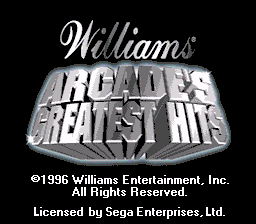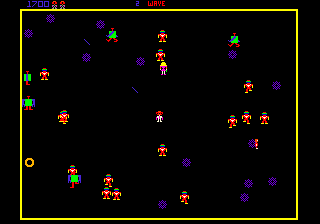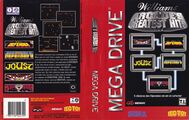Williams Arcade's Greatest Hits (Mega Drive)
From Sega Retro
- For the Sega Saturn game, see Midway Presents Arcade's Greatest Hits (Saturn).
| Williams Arcade's Greatest Hits | |||||||||||||||||||||||||
|---|---|---|---|---|---|---|---|---|---|---|---|---|---|---|---|---|---|---|---|---|---|---|---|---|---|
| System(s): Sega Mega Drive | |||||||||||||||||||||||||
| Publisher: Williams Entertainment (US), T-HQ International (Europe) | |||||||||||||||||||||||||
| Developer: Digital Eclipse | |||||||||||||||||||||||||
| Distributor: Tec Toy (BR) | |||||||||||||||||||||||||
| Licensor: Williams Electronics Games | |||||||||||||||||||||||||
| Original system(s): Arcade boards | |||||||||||||||||||||||||
| Developer(s) of original games: Williams Electronics | |||||||||||||||||||||||||
| Game total: 5 | |||||||||||||||||||||||||
| Peripherals supported: Six Button Control Pad | |||||||||||||||||||||||||
| Genre: Compilation | |||||||||||||||||||||||||
| Number of players: 1-2 | |||||||||||||||||||||||||
| |||||||||||||||||||||||||
|
Williams Arcade's Greatest Hits is a compilation of arcade games released in 1996 for the Sega Mega Drive. The Mega Drive version was published by Williams Entertainment in North America, which had became part of Midway Games following restructuring and buyouts in the mid-1990s. Midway published the game in Europe as Midway Presents Arcade's Greatest Hits.
Contents
Gameplay
In total, five games are available for play in this compilation. All games can be played by one or two players.
Unlike most games that use six-button control schemes by default when a Six Button Control Pad is detected, the MODE button must be pressed during gameplay to enable the six-button controls for Defender II and Robotron 2084.
| Defender (1980) | |
|---|---|
| Defender is a 2D side-scrolling shoot-'em-up. The player controls a starship flying above the surface of a planet and must shoot alien invaders, avoid projectiles and obstacles, and protect humans on the ground from being captured. It is the primary influence for the Sega classic, Fantasy Zone. Attack waves of alien invaders warp in at the beginning of each level, and the level is completed after every alien has been destroyed.
The ship moves in any direction using the D-Pad. The ship can fly in either direction, left or right, with the environment "looping" to create a "circular" playfield. A miniature view of the entire playfield is shown in the top of the screen, which includes the positions of enemies and humans. The ship fires its main weapon, a long laser beam, with Some alien spacecraft attempt to abduct humans by picking them up from the ground and carrying them to the top of the screen, turning them into fast-moving mutant enemies. The player can free the human by shooting the alien, then catching the human before they fall to their death, and dropping them off on the ground. The ship is destroyed if it is hit by an enemy, but it respawns if the player has an extra ship remaining. It is not harmed by flying into the terrain. Each player starts the game with three ships and earns another ship and another smart bomb for every 10,000 points earned. The game continues indefinitely or until the player runs out of ships. Before starting the game, players can change the number of starting ships (between 1 and 9), the number of points to earn an extra ship and smart bomb (between 1,000 and 999,000 in increments of 1,000 or no bonus), the number of attack waves before each difficulty increase (between 0 and 99), the maximum difficulty (between 0 and 99), and the number of attack waves per planet (between 0 and 99 or no new planets). There is a two-player alternating mode where players take turns sharing the same control pad. | |
| Defender II (Stargate) (1981) | |
| Defender II is the sequel to Defender (though, for legal reasons, it only ever known as Stargate in arcades, with the Defender II name used for some of the home releases). As before, it is a 2D side-scrolling shoot-'em-up where the player pilots a starship above a mountainous landscape, destroying all of the alien invaders in a level in order to progress to the next. The game introduces new enemies, a cloaking device, and "Stargates" that the ship can fly through to warp across the playfield.
The ship moves in any direction using the D-Pad. When six-button controls are enabled (by pressing MODE during gameplay), the ship can thrust forward with Some alien spacecraft attempt to abduct humans by picking them up from the ground and carrying them to the top of the screen, turning them into fast-moving mutant enemies. The player can free the human by shooting the alien, then catching the human before they fall to their death, and dropping them off on the ground. If an alien is capturing a human, entering a Stargate warps the player's ship to the human in distress; otherwise, the Stargate warps the ship to the other side of the playfield. If the player has rescued at least four humans, entering a Stargate in one of the first ten levels warps the player ahead by three levels. The ship is destroyed if it is hit by an enemy, but it respawns if the player has an extra ship remaining. It is not harmed by flying into the terrain. Each player starts the game with three ships, and the player is given another ship, another smart bomb, and full Inviso cloaking energy for every 10,000 points earned. The game continues indefinitely or until the player runs out of ships. Before starting the game, players can change the number of starting ships (between 1 and 20), the number of points to earn an extra ship and smart bomb (between 1,000 and 50,000 in increments of 1,000 or no bonus), the difficulty level (between 1 and 5), the Inviso cloaking time for each ship (between 5 and 20), the number of rescued humans needed to use a Stargate to warp (between 2 and 10), and the last level where the player can use a Stargate to warp (between 1 and 99). There is a two-player alternating mode where players take turns sharing the same control pad. | |
| Joust (1982) | |
| Joust is a single-screen platform game in which players control a knight riding a large bird (an ostrich for player one and a stork for player two). The level contains several platforms and wraps around in both directions (so walking through one side of the screen moves the knight to the other side). The knights must defeat the enemy knights riding buzzards by jumping on top of them. All knights are armed with lances, as in traditional jousting, and the knight whose lance is higher wins the engagement; if the lances are at the same level, both knights are repelled away. Defeated enemies are turned into eggs, which can be collected for bonus points; if not collected in time, the eggs hatch into more difficult enemy knights. The level ends when all of the knights have been defeated and their eggs have been collected or hatched.
The knights can move with A player loses a life if the player's knight is unseated by an enemy or the other player. Each player starts the game with five lives and earns another for every 20,000 points earned. The game continues until the players run out of lives or decide to stop playing. Before starting the game, players can change the number of starting lives (between 1 and 99), the number of points to earn an extra life (between 1,000 and 99,000 in increments of 1,000 or no bonus), and the difficulty level (between 0 and 9). There is a two-player cooperative mode where players play simultaneously using separate control pads. | |
| Robotron 2084 (1982) | |
| Robotron 2084 is a dual-joystick top-down shoot-'em-up. In the year 2084, robots have started a war against humans, and the player must attempt to save the last surviving human family from them. It is considered a predecessor to Smash TV, as it was created by the same developer and uses a similar control scheme. This game traditionally causes problems on systems with less than four face buttons (such as the Mega Drive), as eight-directional firing is hindered without a means to emulate the dual joysticks, making the game significantly harder. The game presents the playfield from an overhead perspective, and the player must eliminate all of the enemy robots in a level to progress to the next one. Touching a human rescues the family member for bonus points.
The Robotron hero moves in any direction using the D-Pad on the first control pad. The player can use the D-Pad on the second control pad to fire in any of the eight directions. Alternatively, when using the three-button controls, the player can start firing by pressing The player loses a life if the Robotron hero is killed by an enemy. Each player starts the game with three lives and earns another for every 25,000 points earned. The game continues until the player runs out of lives or decides to stop playing. Before starting the game, players can change the number of starting lives (between 1 and 20), the number of points to earn an extra life (between 5,000 and 50,000 in increments of 5,000 or no bonus), the difficulty level (between 1 and 10), and the controller angle (normal or turned 90°). There is a two-player alternating mode where players take turns sharing the same control pads. | |
| Sinistar (1982) | |
| Sinistar is a top-down shooter similar to Atari's Asteroids. The player controls a spaceship that is flying in a region of space. Destroying planetoids releases small white crystals that can be collected to make a "Sinibomb," which is the weapon necessary for defeating the "Sinistar" at the end of each level. Red enemy worker ships construct the Sinistar during the level. The worker ships cannot harm the player's ship but compete with the player for mining crystals. Once the Sinistar is complete, the player must destroy it to move on to the next zone, where the process repeats.
The ship moves in any direction using the D-Pad. Moving the D-Pad not only moves the ship around in space but also rotates it, which affects its direction of fire. It shoots its gun in the direction that it is facing with The ship is destroyed if it is hit by an enemy, but it respawns if the player has an extra ship remaining. Each player starts the game with three ships, and the player is given another ship at 30,000 points (which increases by another 30,000 points after every bonus ship earned). The game continues indefinitely or until the player runs out of ships. Before starting the game, players can change the number of starting ships (between 1 and 99), the number of points to earn an extra life (between 1,000 and 99,000 in increments of 1,000), the additional points needed for the next extra life (between 1,000 and 99,000 in increments of 1,000 or none), the difficulty level (between 0 and 9), and rapid-fire (yes or no). There is a two-player alternating mode where players take turns sharing the same control pad. |
Production credits
- Lead Programmer and Game Translations (except Joust): Dan Filner
- Joust Translation: George Phillips
- Sound Translation: Terry Coatta, Peter Phillips
- Producer: Andrew Ayre
- Special Thanks: Wes Gale
- Print Design and Production: Debbie Austin, Steve High, Shawn Murphy, Dave Young, Jon Mongelluzzo
- Lead Tester: Jason Shigenaka
- Williams Entertainment Testing: Sunny Chu, Dallas Nunn, Jason Barnes, Jeff Truax, Benjamin Larkin
- Special Thanks: Jim Flaharty, Brian Lowe, Justin Heber, Mike Rubinelli
Magazine articles
Promotional material
Physical scans
| Sega Retro Average | ||||||||||||||||||||||||||||||||||
|---|---|---|---|---|---|---|---|---|---|---|---|---|---|---|---|---|---|---|---|---|---|---|---|---|---|---|---|---|---|---|---|---|---|---|
|
| 64 | |
|---|---|
| Based on 6 reviews | |
Technical information
References
- ↑ Videogame Advisor, "Volume 2, Number 9: September 1996" (US; 1996-0x-xx), page 46
- ↑ Computer Trade Weekly, "" (UK; 1997-02-03), page 17
- ↑ 3.0 3.1 Mean Machines Sega, "January 1997" (UK; 1996-12-06), page 76
- ↑ File:Williams Arcade's Greatest Hits MD credits.pdf
- ↑ File:Williams Arcade Greatest Hits MD US Manual.pdf, page 14
- ↑ EGM², "November 1996" (US; 1996-xx-xx), page 107
- ↑ 1700 igr dlya Sega, "" (RU; 2001-xx-xx), page 263
- ↑ Electronic Gaming Monthly, "December 1996" (US; 1996-xx-xx), page 96
- ↑ GamePro, "February 1997" (US; 1997-xx-xx), page 89
- ↑ Sega Power, "January 1997" (UK; 1996-12-19), page 37
- ↑ Tricks 16 bit, "Tricks Sega Gold 800 igr" (RU; 1998-03-20), page 222
| Williams Arcade's Greatest Hits (Mega Drive) | |
|---|---|
|
Main page | Comparisons | Hidden content | Magazine articles | Reception | Region coding | Technical information | |
| Midway, Williams and Atari compilations for Sega systems | |
|---|---|
| Arcade Smash Hits (1992) | |
| Arcade Classics (1996) | Williams Arcade's Greatest Hits (1996) | |
| Arcade Classics (1996) | |
| Midway Presents Arcade's Greatest Hits (1996) | Midway Presents Arcade's Greatest Hits: The Atari Collection 1 (1997) | |
| Midway's Greatest Arcade Hits Volume 1 (2000) | Midway's Greatest Arcade Hits Volume 2 (2000) | Atari Anniversary Edition (2001) | Midway's Greatest Arcade Hits Volume 3 (unreleased) | |
- Six Button Control Pad-compatible games
- 1-2 player games
- US Mega Drive games
- All US games
- EU Mega Drive games
- All EU games
- UK Mega Drive games
- All UK games
- BR Mega Drive games
- All BR games
- Mega Drive games
- 1996 Mega Drive games
- All 1996 games
- Mega Drive game compilations
- All game compilations
- All games
- Williams Arcade's Greatest Hits (Mega Drive)














